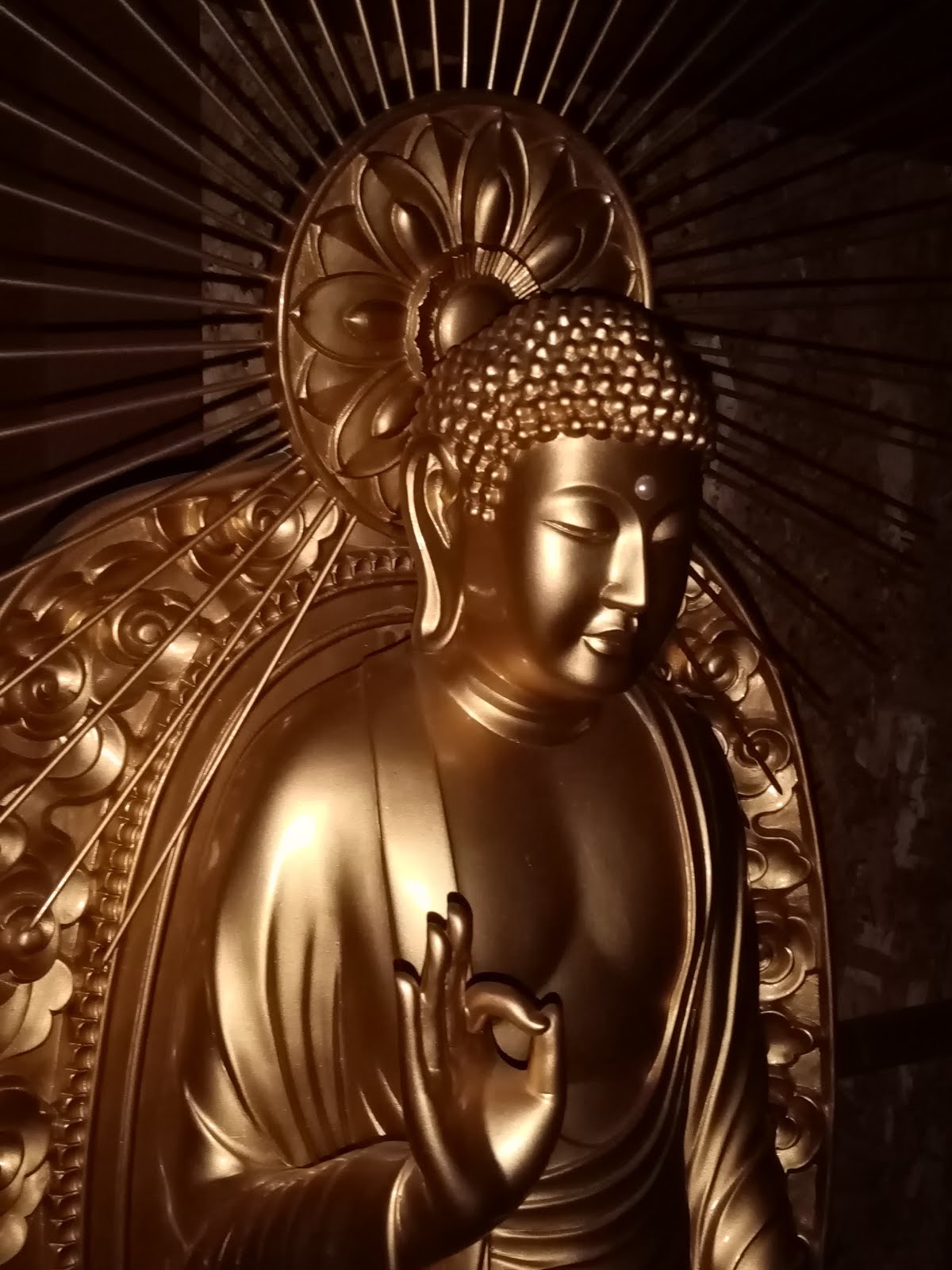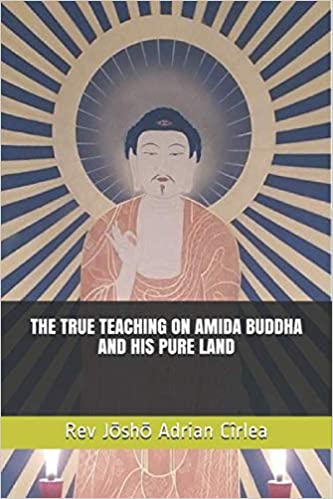There is no fear on the Path of the Buddha. There is no
loneliness perceived as alienation or abandonment. If these feelings do show
up, don’t fool yourselves: for they are only in your head and not real. Please,
do not misunderstand Buddha’s Wisdom and Compassion, that is, do not try to
understand it by means of your narrow mind. Do not use discriminative terms to
explain the Infinite Light and the Infinite Life - the two ways of portraying
Amida Buddha.
Shinran and Honen wondered what was the purpose of Shakyamuni Buddha’s coming to this world. What is in fact the profound signification of the Bodhi Mind related to the Mahayana[1] teaching? Furthermore, what is the purpose of the Enlightenment of a Buddha? Isn’t the Bodhi Mind the aspiration to reach Buddhahood for the sake of all beings? And once this is reached, aren’t all beings invited to partake of it? The Enlightenment of a Buddha isn’t a selfish act, as Nirvana is not selfish in Mahayana.
Seeing things from only one perspective, centered on
yourself, is a limited vision and belongs to ignorant beings, but for a Buddha
or an Enlightened Bodhisattva, the vision is universally centered, everything
being included in His Enlightenment. Discrimination exists only in our mind,
but not in the mind of a Buddha.
So, has Shakyamuni appeared in our world only for a
particular category of people, that is, only for those able to reach Nirvana[2] by
themselves, or in accordance with the Bodhi Mind, His Enlightenment embraces
all beings no matter their capacities? Shinran and Honen thought that the
latter is true as it is in accord with the Buddha’s Infinite Compassion. It
cannot be any other way, because Buddhism would otherwise seem pointless for a
man like me, who is incapable of any virtuous practice and is full of various
attachments.
How many of us are truly capable to do the difficult
practices of a monastery? How many of us are able to have a kind and virtuous
behavior throughout our entire lives? How many of us can reach during our
confused lives, the same level of Enlightenment as Shakyamuni? How many of us
would truly follow the Buddhist way if this way made sense only for those who
are spiritually advanced?
Shinran and Honen believed that Shakyamuni never intended to
exclude certain beings from His Path. If He did, He would have contradicted
himself and the Bodhisattva spirit. That is exactly why Shakyamuni preached the
salvation offered by Amida Buddha and urged all beings, no matter their spiritual
capacities, to rely on Him. Thus, Shinran considered that the true reason of
Shakyamuni’s coming to this world was to preach Amida’s method of salvation:
“The reason for the Buddha’s appearance in the world
Is solely to expound the Primal Vow of Amida, wide and deep as the ocean.
All beings in the evil age of the five defilements
Should believe in the truth
of the Buddha’s words”.[3]
Because this method of salvation is presented in the Larger
Sutra on Amida Buddha[4],
Shinran regarded it to be supreme among all sutras preached by Shakyamuni:
he way to Enlightenment, seeking to save the multitudes of living beings by blessing them with the benefit that is true and real. Assuredly this sutra is the true teaching for which the Tathagata[5] appeared in the world. It is the wondrous scripture, rare and most excellent. It is the conclusive and ultimate exposition of the One Vehicle. It is the right teaching, praised by all the Buddhas throughout the ten quarters. To teach Tathagata’s Primal Vow is the true intent of this sutra; the Name of the Buddha is its essence[6].”
More than this, Shinran considered Shakyamuni to be the
manifestation of Amida Buddha and he clearly expressed this in Shoshinge:
Took the form of Sakyamuni Buddha
And appeared in Gaya.”
Nagarjuna[7], considered by all Mahayana schools as the second in importance after Shakyamuni and one of their most important Patriachs, also urged all beings to rely on Amida. Maybe most Buddhists know about Nagarjuna from his subtle writings on emptiness, but they forget or they don’t know that he also sought refuge in Amida and was reborn in the Pure Land after passing away.
In the chapter entitled “The Way of Easy Practice” from the
volume Dasabhumika-vibhasa-sastra (Commentary
on the ten-stages Sutra), he speaks about two types of practices: a hard
one, based on personal power, similar to an arduous journey on land, and an
easy one, based on the Compassion of the Buddhas, similar to a pleasant voyage
sailing on water. Even though he recommends the easy way to those incapable of
great personal efforts, which may lead to the impression that Nembutsu is for
“lesser” beings only, he himself, a bodhisattva of high attainment, also seeks
refuge in Amida as he writes:
“The Buddha of Infinite Light and Wisdom,
whose body is like a mountain of genuine gold,
I worship with my body, speech and heart
by joining hands and bowing down toward Him.
If anyone is mindful of that Buddha’s infinite power and merit,
He will instantly enter the Stage of Assurance[8].
So I am always mindful of Amida.”
Thus, in the end, the Nembutsu or the saying of “Namo Amida Bu”, turns out to be a universal practice, for both the “inferior” and “superior” beings. Amida Buddha’s Compassion does not draw a distinction between the two. Again Nagarjuna writes:
“All the sages and the saints, all people and gods seek refuge in Him,
That’s why I also take refuge in Him, and worship Him.”
In Buddhist history, there are many examples of spiritually evolved Masters[9] who, even though they followed practices based on personal power, still felt the need to recite the Nembutsu and seek refuge in Amida. They recommended this practice to their disciples, too. Therefore, if even these wise masters relied on Amida’s Compassion, thus showing how hard it is to become free from birth and death, how much more should we, people of this confused modern era, seek refuge in Amida.
Shinran said in Tannisho:
“Since it is extremely difficult to free oneself from blind passions and the hindrances of karmic evil in this life; even the virtuous monks who practice the Shingon and Tendai[10] teachings pray for Enlightenment in the next life. In our case, what more need be said? We lack both the observance of precepts and the comprehension of wisdom, but when, by allowing ourselves to be carried on the ship of Amida’s Vow, we have crossed this ocean of suffering that is birth-and-death and attain the shore of the Pure Land, the dark clouds of blind passions will swiftly clear and the moon of Enlightenment, true reality, will immediately appear. Becoming one with the unhindered light filling the ten quarters, we will benefit all sentient beings. It is at that moment that we attain Enlightenment.”
[1] Mahayana or Buddhism of the Great Vehicle has the goal of leading all beings to attain Buddhahood. On this path the follower aspires to become a Buddha not only for himself, but for the liberation of all sentient beings. Mahayana represents a great number of schools which relies on the Sanskrit canon. The Pure Land tradition, which also contains many schools, is one of the main streams of Mahayana Buddhism.
[2] Nirvana comes from the term „nirv” – „to extinguish”, and is wrongly understood by many as becoming nothingness. However, „Nirvana” means to extinguish the flame of blind passions and illusions and to wake up to the true reality or Buddha-nature which all beings possess. In the Jodo Shinshu school, the state of Nirvana or Buddhahood is to be attained in the moment of birth in the Pure Land of Amida, after the death of our illusory body.
[3] Shoshinge.
[4] The Sutra on the Buddha of Infinite Life.
[5] Tathagata is another word for Buddha.
[6] Passages on the Pure Land Way
[7] Nagarjuna (approximately 150-250), is dubbed the”father of Mahayana Buddhism” and is famous for his rejection of any affirmation about the ultimate nature of reality in the Mahayana doctrine of emptiness. He founded the school of Madyamika (Middle Path) dialectics. The teachings of this school, together with the Yogacara teachings are the basis of Mahayana theory and practice. Also, he is considered by Shinran as one of the seven Patriarchs of the true Pure Land teaching (Jodo Shinshu), due to his works related with Amida Buddha.
[8] The stage of non-retrogression.
[9] Another important figure well known in Mahayana Buddhist schools is Vasubandhu (approx. 320-400), exponent of Yogacara (“the practice of unifying meditation”) teachings which explain all plains of existence in terms of consciousness and teach the meditation about the relationship between personal conscience and the universe, as well as reaching supreme Enlightenment by realizing the inseparable unity between the two. As a Pure Land devotee, he wrote The Hymn of Aspiring towards Birth: Discourse about Amida Sutra, in which he explained the theory and practice based on contemplation of Amida Buddha, the Pure Land, and the Bodhisattvas who dwell there. At the beginning of the hymn he addresses to Shakyamuni and expresses his devotion towards Amida:
“O World-Honored One, with singleness of mind, I take refuge in the Tathagata of Unhindered Light Shining throughout the Ten Directions, and aspire to be born in the Land of Peace and Bliss.”
[10] Two famous Japanese Buddhist schools in the time of Shinran Shonin.


























0 comentarii:
Post a Comment